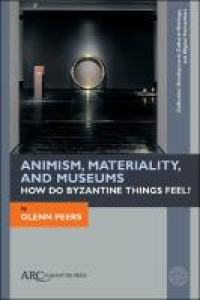
Text
E-Book Animism, Materiality, and Museums: How Do Byzantine Things Feel?
Penilaian
0,0
dari 5Among our most cherished modern assumptions is our distance from the material world we claim to love or, alternately, to dominate and own. As both devotional tool and art object, the Byzantine icon is rendered complicit in this distancing. According to well-established theological and scholarly explanations, the icon is a window onto the divine: it focuses and directs our minds to a higher understanding of God and saints. Despite their material richness, icons are understood to efface their own materiality, thereby enabling us to do the same. That the privileged relation of image to God is based on its capacity for material self-effacement is the basis for all theology of the icon and all art-historical description. It gets more complicated than this definition, to be sure, but the icon is positioned in this way in most straightforward accounts, whether devotional or scholarly. My position is to undermine the transcendentalizing determination of modern theology and aesthetics, and to lean very heavily on the materiality of these things to the point of allowing them, to the degree I can, a voice and life of their own.
Ketersediaan
Informasi Detail
- Judul Seri
-
-
- No. Panggil
-
709.02 PEE a
- Penerbit
- : Arc Humanities Press., 2021
- Deskripsi Fisik
-
178 halaman, ilus.
- Bahasa
-
English
- ISBN/ISSN
-
9781942401742
- Klasifikasi
-
709.02
- Tipe Isi
-
text
- Tipe Media
-
computer
- Tipe Pembawa
-
online resource
- Edisi
-
-
- Subjek
- Info Detail Spesifik
-
-
- Pernyataan Tanggungjawab
-
Peers, Glenn
Versi lain/terkait
Tidak tersedia versi lain
Lampiran Berkas
Komentar
Anda harus masuk sebelum memberikan komentar
 Karya Umum
Karya Umum  Filsafat
Filsafat  Agama
Agama  Ilmu-ilmu Sosial
Ilmu-ilmu Sosial  Bahasa
Bahasa  Ilmu-ilmu Murni
Ilmu-ilmu Murni  Ilmu-ilmu Terapan
Ilmu-ilmu Terapan  Kesenian, Hiburan, dan Olahraga
Kesenian, Hiburan, dan Olahraga  Kesusastraan
Kesusastraan  Geografi dan Sejarah
Geografi dan Sejarah